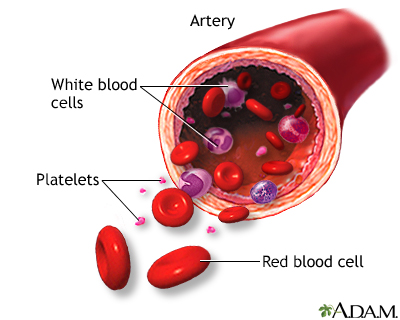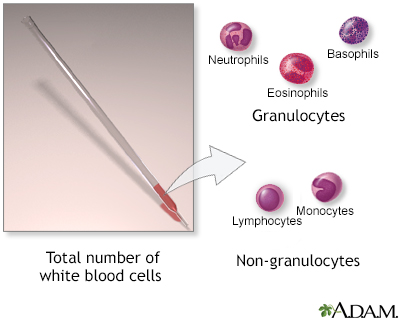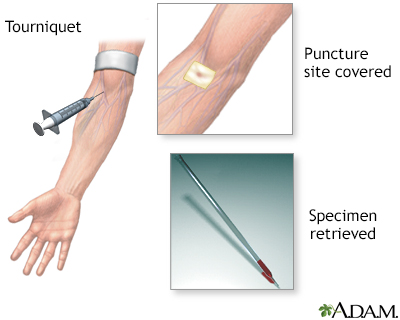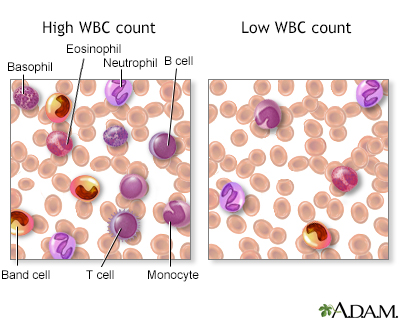WBC count
A WBC count is a blood test to measure the number of white blood cells (WBCs) in the blood. It is a part of a complete blood count (CBC).
WBCs are also called leukocytes. They help fight infections. There are five major types of white blood cells:
Five major types of white blood cells
The blood differential test measures the percentage of each type of white blood cell (WBC) that you have in your blood. It also reveals if there are...

- Basophils
- Eosinophils
Eosinophils
An absolute eosinophil count is a blood test that measures the number of one type of white blood cells called eosinophils. Eosinophils become active...
 ImageRead Article Now Book Mark Article
ImageRead Article Now Book Mark Article - Lymphocytes (T cells, B cells, and Natural Killer cells)
- Monocytes
- Neutrophils
How the Test is Performed
A blood sample is needed.
Blood sample
Venipuncture is the collection of blood from a vein. It is most often done for laboratory testing.

How to Prepare for the Test
Most of the time, you do not need to take special steps before this test. Tell your health care provider the medicines you are taking, including the ones without a prescription. Some drugs may change the test results.
How the Test will Feel
When the needle is inserted to draw blood, some people feel moderate pain. Others feel only a prick or stinging. Afterward, there may be some throbbing or slight bruising. This soon goes away.
Why the Test is Performed
You will have this test to find out how many WBCs you have. Your provider may order this test to help diagnose conditions such as:
- An infection
- Allergic reaction
- Inflammation
- Blood cancer such as leukemia or lymphoma
Normal Results
The normal number of WBCs in the blood is 4,500 to 11,000 WBCs per microliter (4.5 to 11.0 × 109/L).
Normal value ranges may vary slightly among different labs. Some labs use different measurements or may test different specimens. Talk to your provider about your test results.
What Abnormal Results Mean
LOW WBC COUNT
A low number of WBCs is called leukopenia. A count less than 4,500 cells per microliter (4.5 × 109/L) is below normal.
Neutrophils are one type of WBC. They are important for fighting infections.
A lower than normal WBC count may be due to:
- Bone marrow deficiency or failure (for example, due to infection, tumor, or abnormal scarring)
- Cancer treating drugs, or other medicines (see list below)
- Certain autoimmune disorders such as lupus (SLE)
SLE
Systemic lupus erythematosus (SLE) is an autoimmune disease. In this disease, the immune system of the body mistakenly attacks healthy tissue. It c...
 ImageRead Article Now Book Mark Article
ImageRead Article Now Book Mark Article - Disease of the liver or spleen
- Radiation treatment for cancer
- Certain viral illnesses, such as mononucleosis (mono)
Mononucleosis (mono)
Mononucleosis, or mono, is a viral infection that causes fever, sore throat, and swollen lymph glands, most often in the neck.
 ImageRead Article Now Book Mark Article
ImageRead Article Now Book Mark Article - Cancers that damage the bone marrow
- Very severe bacterial infections
- Severe emotional or physical stress (such as from an injury or surgery)
- An ethnic/genetic trait (not uncommon in African Americans)
HIGH WBC COUNT
A higher than normal WBC count is called leukocytosis. It may be due to:
- Certain drugs or medicines (see list below)
- Cigarette smoking
- After spleen removal surgery
Spleen removal surgery
Spleen removal is surgery to remove a diseased or damaged spleen. This surgery is called splenectomy. The spleen is in the upper part of the belly, ...
 ImageRead Article Now Book Mark Article
ImageRead Article Now Book Mark Article - Infections, most often those caused by bacteria
- Inflammatory disease (such as rheumatoid arthritis or allergy)
- Leukemia or Hodgkin disease
Leukemia
Leukemia is a type of blood cancer that begins in the bone marrow. Bone marrow is the soft tissue in the center of the bones, where blood cells are ...
 ImageRead Article Now Book Mark Article
ImageRead Article Now Book Mark ArticleHodgkin disease
Hodgkin lymphoma is a cancer of lymph tissue. Lymph tissue is found in the lymph nodes, spleen, liver, bone marrow, and other sites.
 ImageRead Article Now Book Mark Article
ImageRead Article Now Book Mark Article - Tissue damage (for example, burns)
- Pregnancy
There may also be less common reasons for abnormal WBC counts.
Drugs that may lower your WBC count include:
- Antibiotics
- Anticonvulsants
- Antithyroid drugs
- Arsenicals
- Captopril
- Chemotherapy drugs
- Chlorpromazine
- Clozapine
- Diuretics (water pills)
- Histamine-2 blockers
- Sulfonamides
- Quinidine
- Terbinafine
- Ticlopidine
Drugs that may increase WBC counts include:
- Beta adrenergic agonists (for example, albuterol)
- Corticosteroids
- Epinephrine
- Granulocyte colony stimulating factor
- Heparin
- Lithium
Risks
There is little risk involved with having your blood taken. Veins and arteries vary in size from one person to another, and from one side of the body to the other. Obtaining a blood sample from some people may be more difficult than from others.
Other risks associated with having blood drawn are slight, but may include:
- Excessive bleeding
- Fainting or feeling lightheaded
- Multiple punctures to locate veins
- Hematoma (blood accumulating under the skin)
- Infection (a slight risk any time the skin is broken)
Reviewed By
Mark Levin, MD, Hematologist and Oncologist, Monsey, NY. Review provided by VeriMed Healthcare Network. Also reviewed by David C. Dugdale, MD, Medical Director, Brenda Conaway, Editorial Director, and the A.D.A.M. Editorial team.
Marcogliese AN, Hensch L. Resources for the hematologist: interpretive comments and selected reference values for neonatal, pediatric, and adult populations. In: Hoffman R, Benz EJ, Silberstein LE, et al, eds. Hematology: Basic Principles and Practice. 8th ed. Philadelphia, PA: Elsevier; 2023:chap 159.
Vajpayee N, Graham SS, Bem S. Basic examination of blood and bone marrow. In: McPherson RA, Pincus MR, eds. Henry's Clinical Diagnosis and Management by Laboratory Methods. 24th ed. Philadelphia, PA: Elsevier; 2022:chap 31.






 All rights reserved.
All rights reserved.